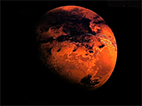
 |
Marte: sedimentos ou impactitos?Publicado em: 11/06/2013 10:58:00 
Um ponto altamente relevante foi levantado por Frank Guardia, um experiente geólogo de exploração, fundador de várias junior companies no Brasil e Canadá,
que, nas horas vagas, é um pesquisador voraz sobre meteoritos, cometas e outros corpos estelares. Frank tem algumas idéias bastante interessantes sobre os impactos de meteoritos na Terra. Neste caso ele entrou de sola e falou o que muitos geólogos também perceberam mas não falaram: será que os "sedimentos" descritos pelas sondas enviadas à
Marte como a Curiosity são realmente sedimentos? Ou serão ejecta, impactitos
gerados após os impactos de meteoritos como tufos, brechas e aglomerados
transportados ou não pela água. Não há como negar o ponto levantado pelo Frank, que copiou neste email que me enviou, o Jonathan Amos, o principal
correspondente científico da BBC News. É só olhar para a superfície de Marte que veremos a marca de milhões de impactos de meteoritos que, com certeza, geraram
milhões de toneladas de ejecta que se acumularam em todos os rincões do planeta.
A chance de encontrarmos esses impactitos na superfície pode ser bem maior do que os afloramentos de sedimentos antigos. A NASA, por não ter falado sobre essa hipótese, foi pega de calça curta pelo Frank. Realmente os geólogos dela pisaram na bola pois só falam de sedimentos e
de água. A NASA está tão preocupada em provar a existência de vida em Marte que está se tornando parcial, vendo somente as evidências que reforçam essa teoria em uma
geologia que deve ser imparcial. Acredito que Marte teve, muito tempo atrás uma atmosfera mais densa e, também, mares internos e rios, que naturalmente formaram rochas sedimentares e, possivelmente, vida. No entanto o planeta sofreu um evento catastrófico que
acabou quase que totalmente com a água e com a atmosfera. Esse foi um impacto
gigantesco, que segundo geólogos colocou uma boa parte de Marte no espaço. Daí
os meteoritos marcianos que são frequentemente descritos aqui na Terra. Ponto para o Frank! (veja abaixo) Hello once more, Pedro: First, congratulations on your article of yesterday, Bandidos e Mocinhos: a
mineração e o meio ambiente; a superb and detailed piece of work, written while
all the time I was bugging you with my own ideas. I address this to you primarily, as from your writings from time to time in
your O Portal do Geológo, you give some important new insights to your readers
on current space technology. For example, recently you reported on the
news given out by NASA regarding early results coming in from the Curiosity
Rover operating, still very tentatively, on the surface of Mars; the sort of
important news most of your readers would otherwise miss entirely. So I thought that you would enjoy some very current news, written by Jonathan
Amos, the principal Science correspondent for BBC News, on the latest activities
of that marvelous machine Curiosity:
http://www.bbc.co.uk/news/science-environment-22832673 Personally, I have not the slightest doubt that water was once plentiful on
Mars and played a very significant role in shaping its topography, but what I am
complaining about is the flamboyant, sensational reporting of facts and proofs,
based on false premises. Don’t think for one minute that I denigrate the sterling reporting of
Jonathan Amos, I certainly do not. It is that I think that all scientists,
such as you and I, and even those of the incomparable NASA, require periodic
reorientation of their ideas and objectives, by just coming back down to Earth
for a while. Respectfully Frank Guardia
Geologia e Mineração contadas por quem entende |
palavra com mais de 2 letras
| O Portal do Geólogo Editor: Geólogo Pedro Jacobi |